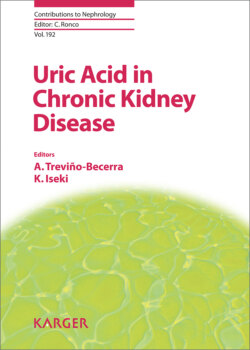Читать книгу Uric Acid in Chronic Kidney Disease - Группа авторов - Страница 23
На сайте Литреса книга снята с продажи.
Acute Uric Acid Nephropathy
ОглавлениеAlthough it is widely recognized that markedly elevated levels of uric acid can cause acute renal failure (ARF), by crystal deposits, the possibility that uric acid may affect renal outcomes at concentrations that do not lead to tubular obstruction have not been considered.
Tumor lysis syndrome (TLS) is a major metabolic disorder, which is frequently found after cell destruction produced in most cases subsequent to the initiation of cytotoxic therapy, used in a variety of cancers including lymphoma and leukemia, which could lead to acute uric acid nephropathy [6]. Rapid cell destruction causes an abrupt release of intracellular ions, nucleic acids, proteins, and their metabolites into the extracellular space. Hyperuricemia is the key factor in the pathogenesis of TLS. The lysis results in the release of large amounts of nucleic acids, which are quantitatively converted to uric acid and must be excreted by the kidney. Crystallization damage occurs in TLS when calcium phosphate, uric acid, and xanthine precipitate in the renal tubules and result in inflammation and obstruction. Uric acid can induce renal damage not only by intrarenal crystallization but also by independent crystallization mechanisms such as vasoconstriction, the inability to self-regulate, decreases in renal blood flow, production of oxidation, and inflammation. Initially uricosuria is present, often manifested by uric acid crystals in the urinary sediment. Microscopic or gross hematuria is seen occasionally. It is common for it to present as an acute oliguric renal injury. The pathologic findings in the kidney result from the deposition of uric acid crystals in the collecting ducts, renal pelvis, and ureters, which produce hydronephrosis [1, 7].
There are several mechanisms by which uric acid may contribute to ARF. First, renal vasoconstriction by inhibition of nitric oxide synthase, reduction in endothelial cell nitric oxide, and stimulation of the renin-angiotensin system lead to ARF. Second, antiangiogenic properties (inhibition of endothelial cell proliferation and migration, stimulation of endothelial cell apoptosis) result in ARF. Third, proinflammatory properties (stimulation of monocyte chemoattractant protein-1 and C-reactive protein, activation of nuclear factor-kappa B and p38 mitogen-activated protein kinase) and pro-oxidative properties (stimulation of oxidants and peroxynitrite-associated radicals), and last alteration of renal autoregulation all lead to ARF [8].
On the other hand, diuretics have been used commonly in the management of ARF to aid in the management of extracellular volume. Diuretics stimulate the reabsorption of uric acid in the proximal tubule, both by inducing direct effects of diuretics on the renal transporters and by causing a reduction in renal perfusion, which secondarily stimulates proximal sodium and urate reabsorption [9].
